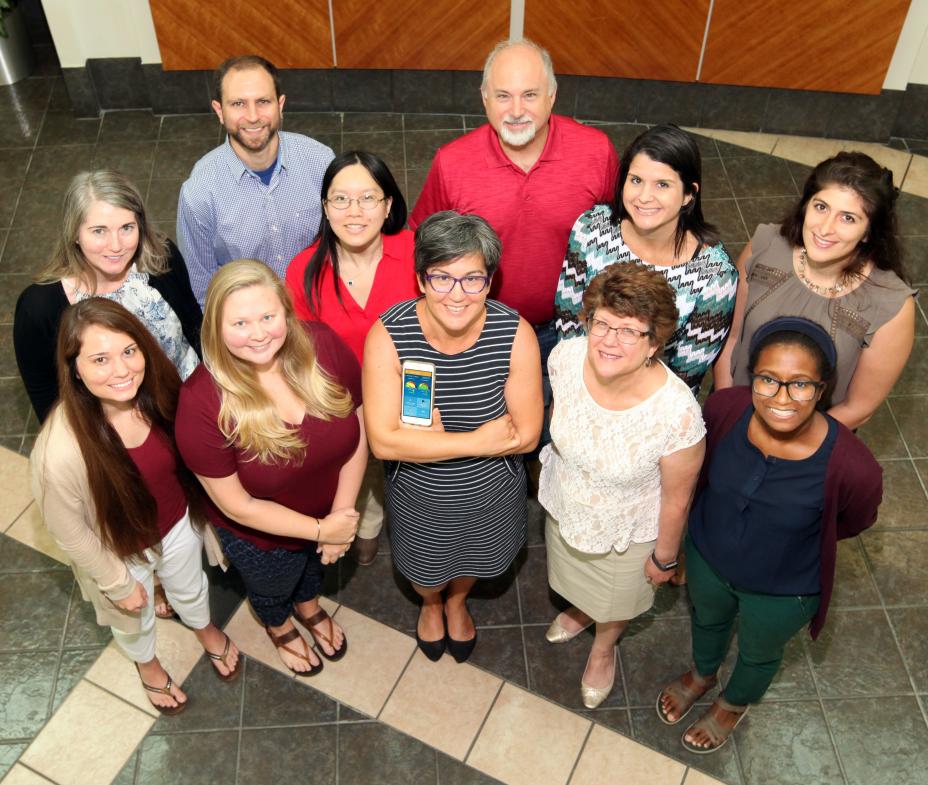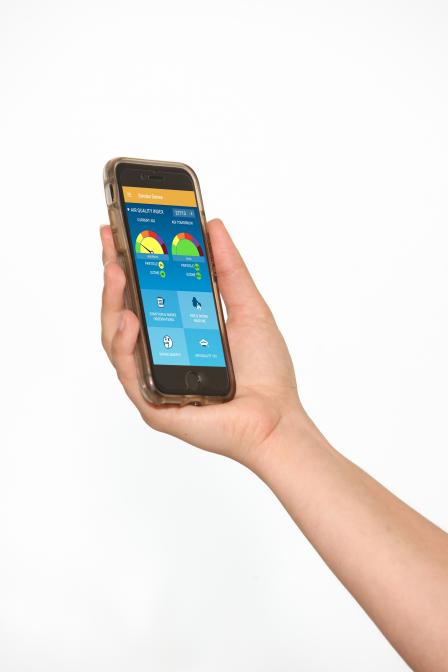A Conversation on the Smoke Sense Research Project for Wildland Fires
Published September 26, 2018
Dr. Ana Rappold is EPA’s lead scientist on the Smoke Sense project, an innovative crowdsourcing study and educational outreach activity. Below she discusses what the team learned from last year’s pilot phase of the project and what they’ve changed for 2018.
What is Smoke Sense?
 The Smoke Sense team. Top row: Mary Clare Hano, Steve Prince, Linda Wei, Bryan Hubbell, Monica Linnenbrink, Christina Baghdikian. Bottom Row: Nicolle Priester, Bailey Stearns, Ana Rappold, Ann Brown, and Lauren Wyatt.The Smoke Sense project combines the power of crowdsourcing with digital technology to reduce the public health burden during wildfire smoke episodes. Individuals can participate in the study by using the Smoke Sense mobile app to learn about wildland fires and smoke health risks in their area. They can also report health symptoms they experience and what actions they would be willing to take to lower their exposure. To the best of our knowledge, Smoke Sense is the only citizen science project that connects changes in environmental conditions to changes in a community’s health.
The Smoke Sense team. Top row: Mary Clare Hano, Steve Prince, Linda Wei, Bryan Hubbell, Monica Linnenbrink, Christina Baghdikian. Bottom Row: Nicolle Priester, Bailey Stearns, Ana Rappold, Ann Brown, and Lauren Wyatt.The Smoke Sense project combines the power of crowdsourcing with digital technology to reduce the public health burden during wildfire smoke episodes. Individuals can participate in the study by using the Smoke Sense mobile app to learn about wildland fires and smoke health risks in their area. They can also report health symptoms they experience and what actions they would be willing to take to lower their exposure. To the best of our knowledge, Smoke Sense is the only citizen science project that connects changes in environmental conditions to changes in a community’s health.
But Smoke Sense is more than a study. It is also an educational tool and information resource designed to increase people’s awareness of the health impact of smoke and encourage people to take action to protect themselves. Developing the app was a unique collaboration of scientists and communication staff. From the beginning, the team engaged users in a two-way conversation to plan and implement the study.
How did you get interested in the health impacts of wildfires?
Wildfire smoke currently impacts many communities and these trends are expected to continue in the future. Most people only look for information on smoke and how to avoid it once they need the information. After publishing several papers on impacts of smoke on our health, EPA scientists wanted to explore how existing science and resources could be used to create communication tools that will help protect communities from fire and smoke.
Why did you decide to use an app for Smoke Sense?
Our phones are increasingly powerful and are the technology of choice for many folks; some argue surpassing a PC or laptop. Apps are a great way to get information to individuals who use this technology. We wanted to explore if an app could help us learn more about health issues people may be experiencing during a smoke event and whether this information would provide insights into ways to effectively communicate health risks.
Why are you conducting Smoke Sense for a second wildfire season?
The pilot in 2017 was our first experience with deploying an app and using it in crowdsourcing research. We gained considerable knowledge and have made some changes to enhance the app experience, encourage participation and provide us with more information to support the research.
What response did you receive from the public and stakeholders to the 2017 pilot?
Conducting a crowdsourcing project is different than population studies since you put something out there like an app and hope people find it, like it, and want to participate. We were very pleased with the positive and large response to the pilot and app and the high percentage of return app users. More than 5,000 participants used the app in 2017 and there were more than 50,000 unique sessions with a 93 percent return rate. Individuals, as well as partner organizations, provided great feedback about using the app as an informational resource during wildfire and smoke events.
Have you made any upgrades or changes to the app for 2018?
Based on our evaluation of the pilot and feedback we received from users and interested groups, we have made several updates that we think improve the mobile app. These changes include a user interface upgrades as well as added modules, which engage in learning about smoke exposure and thinking about health. Changes include: additional map layers that provide detailed information about fires and smoke from Inciweb, 24-hour forecasts of smoke and ozone from the National Oceanic and Atmospheric Association NOAA, educational stories in a component called Smoke Smarts, and streamlined user tutorials and information buttons
What challenges have you encountered using the app?
We observed some confusion as to why some areas did not have air quality information, which is provided by EPA’s Air Quality Index. While there may be a smoke event in a community, the air quality data comes from a national monitoring network, which may not have a monitor close to a city or town. This can lead to potential gaps in data for a local area. For the next version of the app, we added “i” buttons to give additional information about where the data comes from and how frequently. We are also developing STEM curriculum around smoke for K-12 as part of Smoke Sense project.
What did you learn from users?
Users reached out to us through our Smoke Sense email (smokesense@epa.gov) to ask questions and share their experiences with the app. While the app is not designed to be the primary source of information on safety and health for individuals during a smoke event, we did hear about health problems from individuals related to smoke exposure and they had questions on where they should go to get more information. We directed them to contact their health care provider and to the AirNow.gov webpage to learn more about air quality and health.
We have also conducted in-depth interviews with a small group of organizational leaders in state and local health and environmental agencies. These interviews are helping us understand the different ways individuals and communities experience smoke, as well as their motivations for participating in Smoke Sense and how the project might be useful to their communities and organizations. We are analyzing these interviews and will publish findings in the coming months.
What results do you have so far?
We are still analyzing the data and plan to publish the findings from the pilot in 2018. Additional publications are planned after the second year of the study.
Have questions for Smoke Sense? Email: smokesense@epa.gov
Learn more about the Smoke Sense Project, get updates, and download the app at https://19january2021snapshot.epa.gov/air-research/smoke-sense

